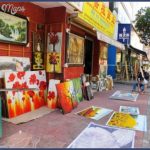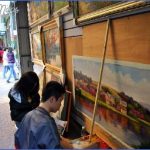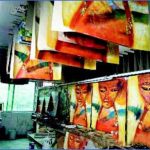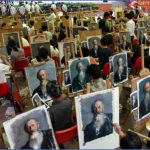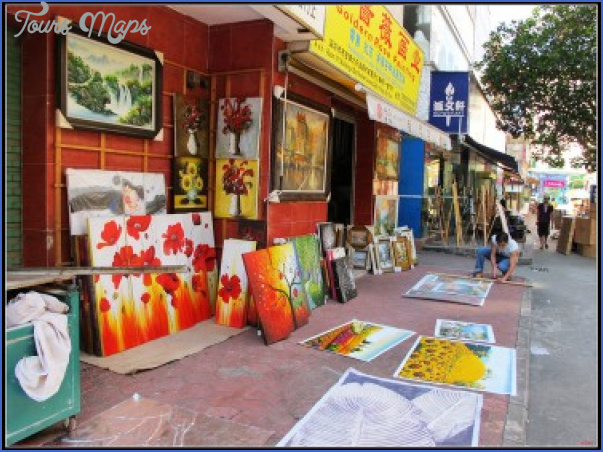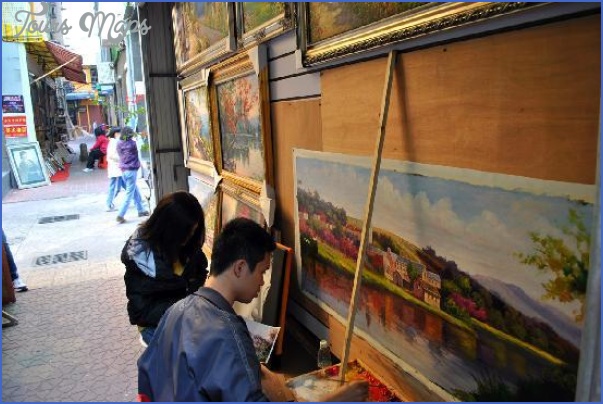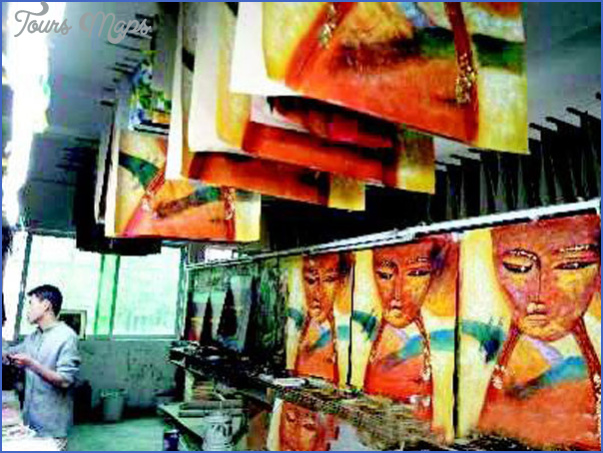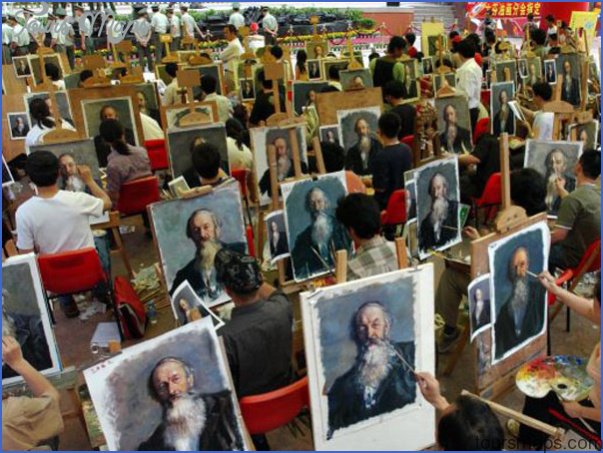Is there anywhere on earth quite like Da Fen? This is a Shenzhen absolute must.
In 1988, a Hong Kong businessman named Wong Kong, who had a business making and selling reproductions of classical and other oil paintings, decided that, with rising costs, there was no future in Hong Kong and set up shop in Da Fen Village, just outside the zone in Buji Town. His sole reason for choosing Da Fen was because the rents were cheap.
This set off an explosion of interest in commercial art. China has an extensive network of Art Colleges, but not necessarily the jobs to keep the graduates occupied. There are also many talented painters working in the rice paddies who are keen to have the opportunity to earn more money than they can in agriculture while at the same time practising their craft. The People’s Daily recently reported that a competent artist in Da Fen can earn US$10,000 per annum, ten times what he can earn in the fields.
Thus Da Fen Oil Painting Village was born. It was originally a Hakka wei or walled village. You can still make out the square shape of the original village but, with the exception of two ancestral temples, modern four or five storey buildings have replaced the old buildings. Australians who are used to the idea of big statues commemorating local industries, the Big Banana, the Big Merino etc., will be intrigued to know that there is a Big Paint Brush and Easel, a bronze sculpture at the entrance to the village.
You can get any painting you like copied here, even from a photo. Prices vary but you probably shouldn’t pay much more than $250 for best quality. Be sure you ask for best quality; prices vary based on quality. We have had very good service from David Wu at Noah on the first floor of the MOI Art Trading Plaza, just to your right as you get off the bus at Da Fen Village bus stop. Noah specialises in faux antique baroque furniture for the French trade. The French aren’t as picky as the English about art copies. But his people can copy anything. Ask to see his factory on the top floor of the building. You will be fascinated by the painters with large piles of canvasses, some pre-antiqued, in front of them and a palette in their hand. We were told that one of them had done 3000 copies of a particular Raphaelite cherub and that he was pretty good at it by now. Incidentally, if you are inclined to turn your nose up at the idea of production line art, we suggest you read Vasari’s Lives where he makes it quite clear that the studios of Florence and Venice were no different when it came to earning their daily bread.
Apart from the big operators like Noah, there are hundreds of small art shops. Mona Lisa smiles at you from every corner. George Bush in a cowboy pose and President Hu Jintao are also popular subjects and we have been tempted by a five-foot high portrait of the Queen. You can also buy art supplies at competitive prices
And if you think that getting paintings copied is too naff, some of China’s best painters also maintain studios at Da Fen. Good places to look are the first and second floors of MOI, and also in the Da Fen Louvre, just at the bus stop. But don’t expect to pick up any bargains here. You won’t see much change out of $10,000. We love the works of a Tibetan artist who goes by the Chinese name of Chen Changchang. His studio is on the first floor of a new building across the main road just to the north of the old village. When you go into his studio you are first greeted by his bread and butter work that is very competent interpretations in oils of Tang Dynasty ink paintings. But then you go to the back area and you see his real love, portraits in a modern version of the traditional Chinese style, black and brown predominating, angles, a mixture of slight perspective and traditional flat scenes, blank faces. We loved a picture of a man standing amongst rubble holding up a broken concrete pillar Samson style. We had previously seen this picture in an exhibition of art in aid of the Sichuan earthquake. He mentioned prices of between $ 10,000 and $15,000 but it was clear that he’d be prepared to talk.
You can also get your framing done here in too many places for it to be sensible for us to single out any one. We’ve been doing framing forever. We know what it’s all about. But none of that prepared us for what we experienced in Dafen.
We wandered into one of the small framing shops. The smell of paint, the sounds of sawing, dust on everything. There are always small kids in Dafen shops and two of them were in a corner throwing things at each other. A man in a whitish singlet emerged from a room. We showed him the pirated copies of some of our favourite artist’s works, fresh from the copy room of a factory nearby. He grunted, pulled out a calculator, and did those Masonic calculations which framers are famous for. Then he showed us the result, which was 6467. Six thousand four hundred and forty seven? No. Sixty-four Yuan. Seemed a reasonable number. We asked how long it would take. He held up two fingers. Hey! We know framing. Be clearer. Two weeks or two months? No. He was sorry. It was lunchtime and some of his workers were eating. Come back in two hours and it’d be ready. And it was!
There is also an official art gallery, the Dafen Art Gallery. This is a new modern building on the outskirts of the town area proper. It is an example of the style of gallery building that is all angles; galleries on different levels all filled with bright natural light which streams in through skylights and high clerestory windows. The gallery doesn’t appear to have a permanent display as yet and at present it is given over to exhibitions of Dafen artists and art shops.
Da Fen is one of the many places in Shenzhen being remodelled and improved constantly. Unfortunately the trend in the 1980’s to put up ugly six or eight story blocks on community land took hold here but new pedestrian areas and redesigned facades provide areas for coffee shops and eating places where you can stop for refreshment in between examining the amazing range of works of art.
But when you’ve finished doing that, take a small look around what remains of the old village. It’s divided into two parts. The old wei is a square area with a chequerboard arrangement of streets and the new wei can be seen around it in a roughly oval shaped area. To the north of the town is a square with the Ancestral Temples of the Hong and Wu clans skirting it. Unfortunately they are firmly padlocked. You should take tea at the Qi Xing, Seven Stars Tea Shop. This is built around several old Hakka houses. The artist who owns it has done a great job of incorporating the houses with new materials in the traditional style. He charges to go in but it’s worth it when you sit and drink tea and take in the atmosphere. It’s like being inside a Chinese scroll.
There is a quite good bronze bust of Leonardo Da Vinci in the square. There is a particularly Shenzhen subtext to this. The first two characters of Da Vinci’s Chinese name, Da Fen Qi are, either by accident or design, the characters of Dafen’s name.
Address: Dafen Village, Buji,
Buses: 300, 372 and 357. Da Fen You Hua Cun stop.
Website: http://www.cndafen.com/index.php/Index/index.shtml
PAINTING AND SCULPTURE DA FEN OIL PAINTING VILLAGE SHENZHEN Photo Gallery
Maybe You Like Them Too
- The Best Cities To Visit in The World
- World’s 10 Best Places To Visit
- Coolest Countries in the World to Visit
- Travel to Santorini, Greece
- Map of Barbados – Holiday in Barbados

